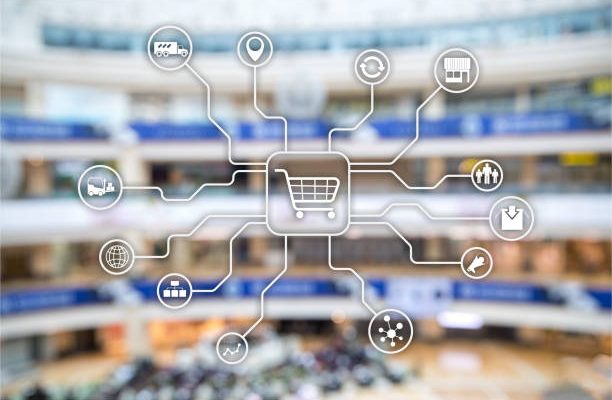Multichannel retailing was born as digital retail became more popular in the 2000s. Multichannel retailers sell and promote their products through traditional and e-commerce platforms, catalogs, and storefronts. 1
The technology has evolved, and so have the possibilities to reach customers beyond traditional ecommerce sites. Omni-channel retailing is a strategy that savvy businesses are increasingly using to reach potential customers.
What is omnichannel, and how can it be used to the advantage of businesses? This guide shows how a successful omnichannel strategy can boost a brand’s awareness and increase sales by reaching consumers wherever they are.
What is omnichannel retailing
Multichannel retailing allows consumers to buy products on ecommerce sites. Omnichannel marketing takes the brand to them directly, no matter where they are. The prefix “omni” means “all,” and omnichannel retailing uses all channels available to reach more consumers.
We mean everything when we say omnichannel. This is because it covers a wide range of retail marketing tactics. The integration of retail media advertising into online activity is one of the most obvious and prevalent.
Customers receiving targeted advertising on a streaming service
Social media feeds showing users the products they search for
Encourage users to download an app on their mobile to enhance their service experience
This is the kind of customer experience that omnichannel retailers aim to provide. Each omnichannel retailer aims to provide as many platforms for customers to interact with their brand, learn about it and make purchases.
The omnichannel approach relies on the brand’s presence across all channels to drive sales.
Tetris Effect : Understanding Omnichannel Retailing
The Tetris Effect is a physical and psychological phenomenon named after the arcade classic. The beloved retro videogame has a physiological effect that works as follows: 4
Tetris players spend hours watching falling blocks.
The video gamer finally stops playing for the day in order to give their eyes a rest and their brains a break.
As they try to fall asleep, they see the image of falling blocks across their inner eyelids.
This quirky, temporary, and harmless occurrence is often associated with Tetris. However, any image that repeats can have the same effect.
This is a trend that’s easy to predict in terms of omnichannel retailing. Most marketing strategies don’t aim to have a brand’s image haunt consumers as they fall asleep.
It’s the real prize that companies are looking for omnichannel consumers who think of their brand, either consciously or subliminally, even when they are not directly exposed to it. This translates into:
Brand recognition
Brand recognition
Top of the mind awareness
This coveted trophy of the advertising industry has long been hailed as a marker of successful branding and campaign marketing. Having an omnichannel strategy is a simple and modern way to capture them.
Omnichannel retailing in practice
Immersive marketing is not a new phenomenon. Imagine amusement parks themed around animation companies or sports giants with their logo emblazoned on everything from athletes’ shoes to telecast watermarks.
Some megabrands are known for their presence and products. In the digital age, marketing has changed, and now smaller businesses are able to compete.
Online spaces offer companies a great opportunity to connect with their omnichannel clients. Digital footprints also make it easier to track engagement with brands, which is essential to personalizing the user’s experience.
The goal of omnichannel retailing is to advertise across multiple platforms. However, different consumers will use these platforms for communication, commerce and leisure. A single customer could use all or some of the platforms listed below on any given day.
Meta
TikTok
Other social media apps
Amazon
Online retailers
Brick-and-mortar retail stores
Messenger and WhatsApp are communication apps.
Text messaging
YouTube
Spotify
Entertainment platforms like Netflix, Hulu, and others
Other Media Hosting Sites and Streaming Services
Sites are increasingly becoming interconnected, with Google and Meta logins integrated. Users are increasingly being tracked across multiple platforms, and brands can target them more easily if they don’t take measures to protect themselves.
Create user personas for omnichannel marketing
Create user personas for the most likely consumers to convert. Brands can begin with their first-party customer data and determine which customers have converted and when.
Find out what sites and services they use.
Understanding the types of communication that their audience will respond to
Find out what products your audience wants and how you can advertise them
When a company has a better understanding of the consumer’s preferences and their way of life, they can tailor a more personalized omnichannel experience.
How to reach out to consumers at their level
A retailer who is omnichannel should meet the consumer where they are: physically, emotionally, and digitally. Strong campaigns make the most of:
Social Media- Omnichannel retailing doesn’t only mean maintaining a presence across Twitter, TikTok, and Instagram but also a consistent customer experience. The persona of a brand and the products that a user sees on an app should be consistent.
SMS and email- Messages users perceive as spam may be irritating or off-putting. What if the email contained a coupon for 20% off the item the user was considering? This will increase customer satisfaction and make it easier to close the sale.
Targeted Advertising – Most people recognize ads for what they are, and so the ads must be customized to keep customers engaged. How can a company know which products an individual wants to see on their website? The company has been tracking data on customers, including what they have already bought, the media that they consume, and how they behave in other channels.




















Comments